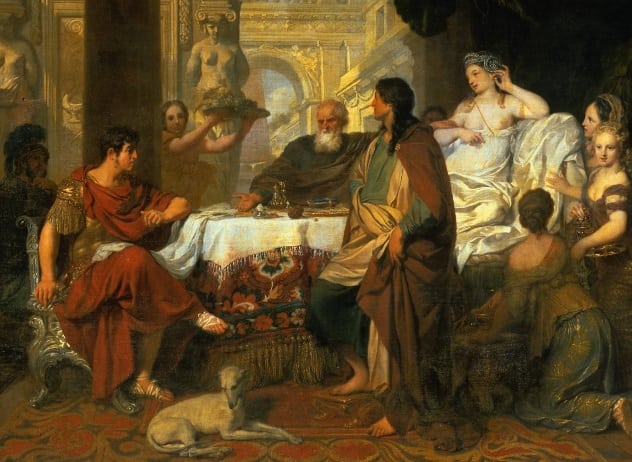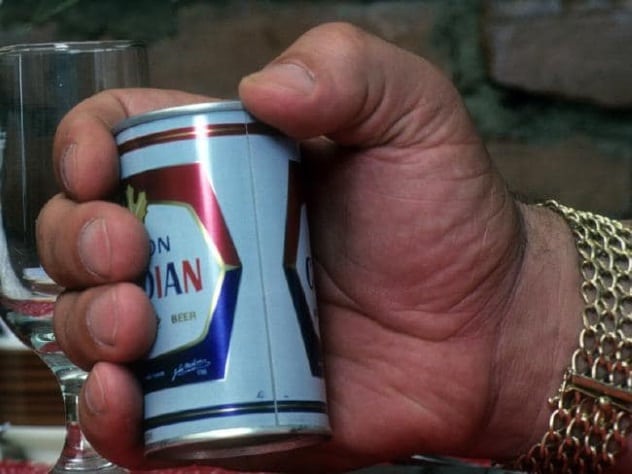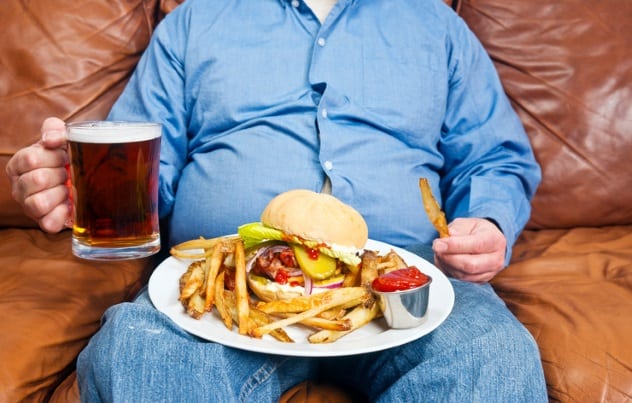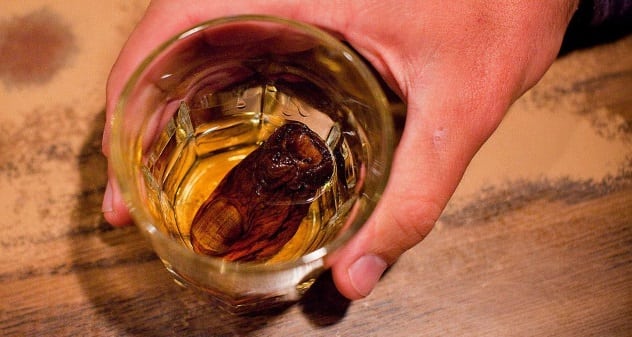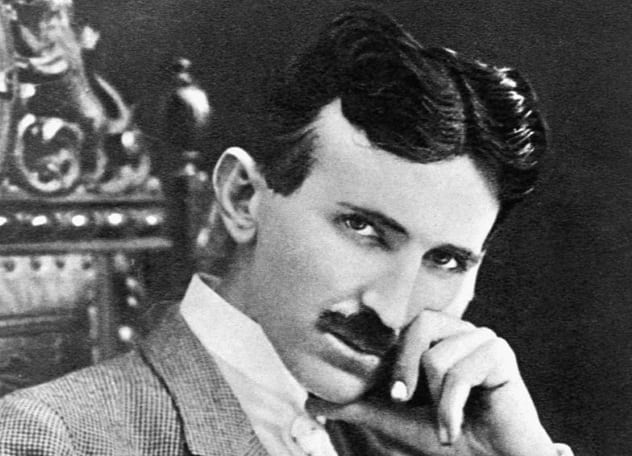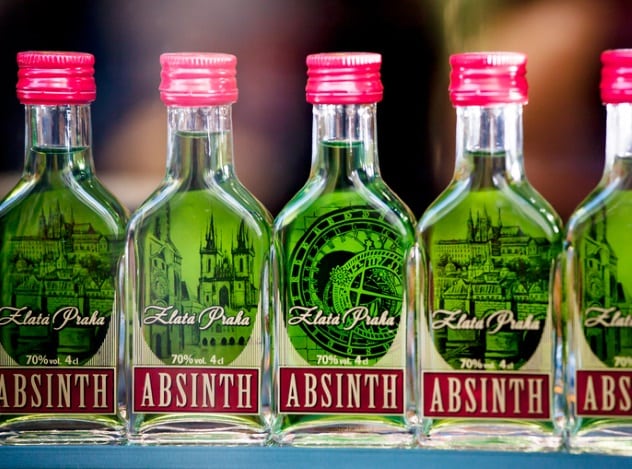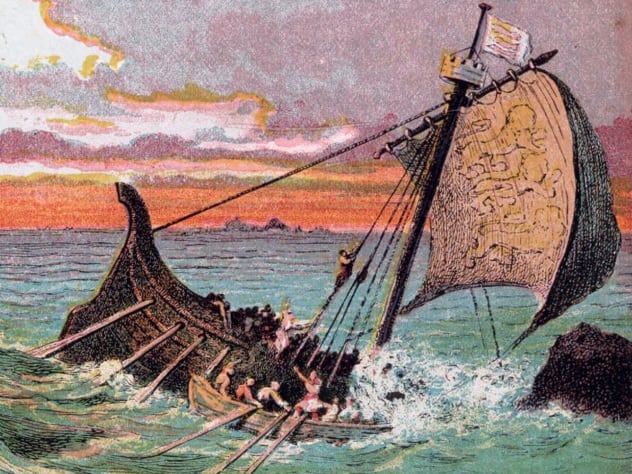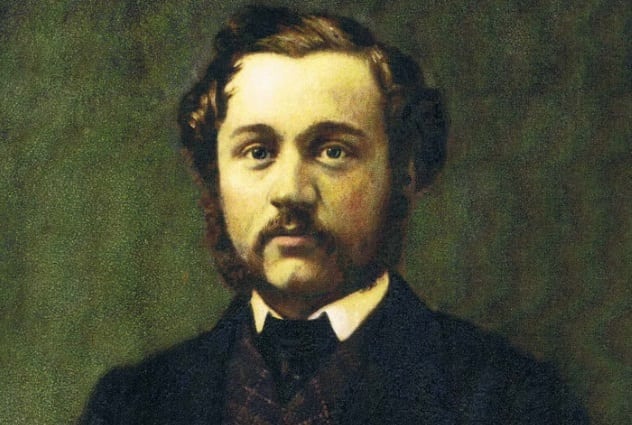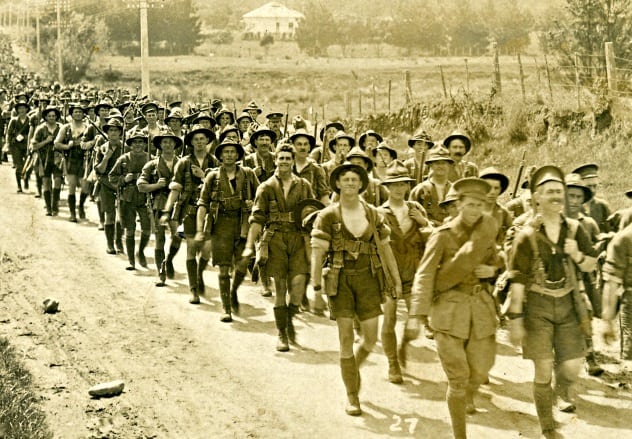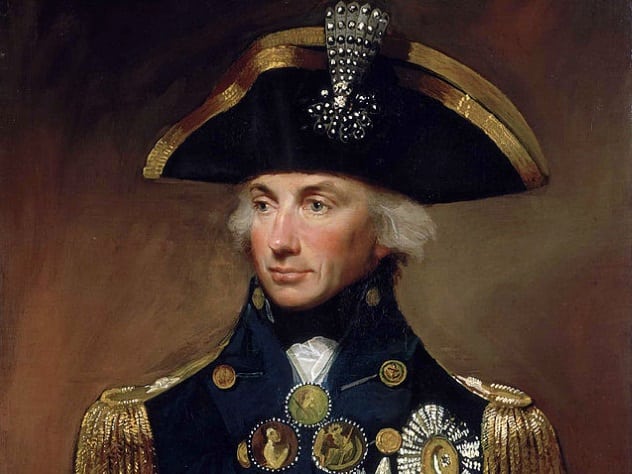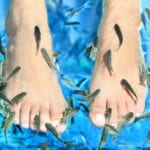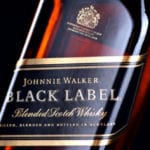The following items might amuse you, amaze you, or disgust you. Some might even do all three. Here are ten stories, myths, and legends about alcohol, sufficient to satiate even the thirstiest pub trivia night ringer.
10 Cleopatra’s Pearl Bet
One of the most infamous stories regarding Cleopatra concerns a bet between her and Marc Antony. As a lavish display of her fabulous wealth, she bet the Roman leader that she could spend ten million sesterces on a single meal. Antony accepted. Cleopatra brought out a glass of wine vinegar. The queen then plucked one of the giant pearls she was wearing on her earrings, dissolved it in the vinegar, and drank it. So did Cleopatra really swallow a ten-million-sesterce pearl in one gulp? The story comes from Pliny the Elder’s iconic Natural History, written about 100 years after the fact. Modern historians doubt its veracity. Modern scientists prefer to avoid debating its authenticity and, instead, test to see if it is even possible. Prudence Jones from Montclair State University in New Jersey replicated the experiment for a paper published in the journal Classical World. Of course, she didn’t have a million-dollar pearl to dissolve, so she used a five-carat one and supermarket white vinegar. Jones found that a one-gram pearl would dissolve within 24 to 36 hours.[1] Not only that, but the calcium carbonate in the pearl neutralizes some of the acidity, making the drink more palatable than plain vinegar. Alternatively, crushing the pearl beforehand and using boiled vinegar speeds up the reaction to just a few minutes. Assuming Pliny took some artistic licenses, there are two scenarios that make the story achievable—either the drink was prepared a few days prior, or the pearl was crushed and mixed into the cup.
9 The Thirst Of A Giant
Andre the Giant’s drinking prowess is the stuff of legends. There are many stories from people who witnessed it firsthand. Hulk Hogan said Andre once drank 102 beers in 45 minutes. Princess Bride co-star Cary Elwes saw the French wrestler mix a variety of liquors into a 1.2-liter (40 ounce) pitcher. Elwes imagined that’s what airplane fuel tasted like, but Andre drank several of these in a single sitting.[2] Fellow wrestler Mike Graham said Andre once downed 156 beers in one session, which would be a world record. However, as there was never an official to document Andre’s feats, these remain just drinking stories. Despite the copious amounts of alcohol he ingested, Andre rarely ever got blackout drunk. His boozing buddies told of only one instance when the giant actually passed out from drinking too much. It happened in a hotel hallway, and Andre was so big that neither the other wrestlers nor the hotel staff were able to move him. Instead, they draped a piano cover over him and let him sleep it off. Hotel guests thought he was a piece of furniture.
8 Is The Beer Belly Real?
Middle-aged men know to fear the dreaded beer belly. This “affliction” is a potbelly found predominantly in older men who consume large quantities of beer. According to this notion, beer, more so than any other food or drink, deposits itself in the form of abdominal fat. One study by Charles Bamforth, professor of food science at the University of California Davis, claims the beer belly is a myth. The alcohol in beer is the same as the alcohol in any other drink and doesn’t have any magical properties that target the gut. Bamforth suggests that the protruding belly is more likely a result of lifestyle. People who consume beer in excess are also probable to overindulge with other products, like fried or fast foods. All those extra calories will give you a paunch; it doesn’t matter if they are coming from beer, wine, or burgers. Alcohol researcher Dr. Aliyah Sohani concurs, arguing that it is also easier to go overboard with beer than with other alcoholic drinks. Beer comes in larger servings and has a lower alcohol content compared to wine and liquors, so you need to drink more to get the same buzz. There could be some truth behind the myth, however. Excessive beer drinking can cause liver disease, which, in turn, can cause a condition known as ascites.[3] This is a buildup of fluid that can cause a protuberant belly and can be found in extreme alcoholics.
7 ‘Your Lips Must Touch The Toe’
If you ever find yourself in Dawson City, Yukon, Canada, you can become a member of the “Sourtoe Cocktail Club.” All you have to do is go to the Downtown Hotel, visit the Sourdough Saloon, and order a shot. You can have any liquor you like, but the drink will include a special ingredient—an amputated toe. The sourtoe cocktail will contain a mummified toe floating in your drink. Not only that, but in order to become a member, you must act according to this mantra: “You can drink it fast, you can drink it slow, but your lips must touch the toe.” The tradition was started in 1973 by Captain Dick Stevenson when he found the mummified toe while cleaning out an old cabin. According to local legend, it belonged to 1920s rumrunner Louie Linken. Along with his brother, Otto, he got caught in a blizzard and took refuge in the cabin. Prior to this, Louie stepped in a puddle, and his toe froze solid. To prevent gangrene, Otto chopped it off with an ax and preserved it in alcohol. The original toe is long gone, swallowed by a miner in 1980. Since then, other people have donated their appendages for the cause. Most recent example happened in April 2018, when Brit Nick Griffiths lost three toes to frostbite while training for the Yukon Arctic ultramarathon.[4]
6 Tesla’s Thoughts On Alcohol
Can chewing gum be worse for your health than drinking alcohol? One man was convinced of this because, according to him, chewing gum exhausted the salivary glands. That man was Nikola Tesla. Undoubtedly a genius, Tesla also had many peculiarities, including a strict diet. He lived mostly on a regimen of milk, water, and vegetables. He usually abstained from eating meat and abhorred tea, coffee, and tobacco. Alcohol, however, was a different story. Tesla considered it a “veritable elixir of life” and drank whiskey daily. As you might imagine, the Serbian inventor was not a fan of Prohibition. He claimed to have obeyed the law and abstained from alcohol during that time, although he said it made him a “very sick man” and caused months of suffering. Tesla made his feelings known publicly in an article published in the New York World Telegram in 1932 titled “Chewing Gum More Fatal Than Rum, Says Tesla.”[5] Tesla blamed the notion that alcohol is bad on dry propaganda. He viewed moderate consumption of alcohol as crucial to good health. It aided thought, speech, and physical exertion by acting as a sterilizer of alimentary channels and preventing infections. Tesla also believed that studies which decried the detriments of alcohol were flawed because they either used drunkards or people weakened by heredity and environment.
5 A Visit From The Green Fairy
Absinthe has a lurid history full of controversies which, eventually, led to the drink being banned en masse throughout Europe and the US at the start of the 20th century. Even to this day, the most infamous characteristic of the “Green Fairy” is that it will give you hallucinations. However, this has never been the case. The supposed culprit is a chemical compound called thujone. It is found in grand wormwood, one of the main ingredients of absinthe. However, although thujone is toxic and a convulsant, there is no evidence to attest that it has psychedelic effects. Moreover, it is only present in absinthe in trace amounts. You would die of alcohol poisoning before drinking enough absinthe to reach toxic levels of thujone. So how did the Green Fairy obtain its reputation? Researcher Ted Breaux believes that absinthe was a convenient scapegoat of the time, targeted both by the temperance movement and the French wine industry.[6] One big story involved a Swiss peasant named Jean Lanfray, who killed his family after binge drinking. He drank a wide range of alcohols, but since absinthe was the hot topic of the day, the media dubbed his killings the Absinthe Murders. A few similar stories decrying the wicked characteristics of the drink were enough to condemn the Green Fairy.
4 One Too Many For The Road
William Aetheling, also called Adelin, was the only legitimate son of Henry I and heir to the throne of England. He died in 1120 while crossing the English Channel in a vessel called the White Ship, which hit a rock and sank near Barfleur off the coast of Normandy. His death triggered a civil war known as the Anarchy, which lasted for 18 years. All of this happened because everyone aboard the White Ship was drunk. The captain of the vessel was Thomas FitzStephen, son of Stephen FitzAirard, who took William the Conqueror across the channel when he invaded England. He presented the ship as a gift to King Henry, but, as he’d already made travel arrangements, he suggested his son William use it. For some reason, the White Ship sailed at night, after all the other vessels left port for England. According to contemporary historians like William of Malmesbury, the 17-year-old heir and his retinue passed the time with wine. When it was time to leave, everyone was “merry” and even drunkenly dismissed the priests who wanted to bless the ship to secure safe passage.[7] The captain was ordered to take the ship to its limit to catch up to the king’s vessel. It hit submerged rocks soon after leaving the harbor. Around 300 people died, and only a butcher named Berold survived. William, at least, was given a somewhat noble death. Chroniclers wrote that he made it to a lifeboat but returned when he heard his half-sister, Matilda, was still aboard. Not that it would have mattered, anyway, since the lifeboat became overcrowded and also sank.
3 The Robin Hood Of Moonshine
Lewis Redmond was born in 1854 in Swain County, North Carolina. He came from a family of moonshiners and was already making home deliveries of his own product by 1876. His life took a dramatic turn on March 1, when he was cornered by US Deputy Marshall Alfred Duckworth. The 21-year-old moonshiner produced a derringer and fatally shot the officer in the neck. From then on, Redmond lived a life on the run, usually hiding in the Blue Ridge Mountains in South Carolina. He stuck with what he did best—making moonshine. His notoriety attracted the attention of other distillers, who rallied under Redmond to fight off revenue officers. Upwards of 30 men rode by his side until his capture in 1881. Redmond’s gang developed a reputation for violence, particularly for raiding the houses of agents on their trail. Despite this, many locals, who had their own disdain for the government, looked at Lewis Redmond as a folk hero. There were even stories of him using money from his moonshine operation to help out poor families, earning him comparisons to Robin Hood. However, these might have been embellishments from local newspapers eager to appeal to their fan base. When there was finally no way out, Redmond tried to go out in a hail of bullets. He exited the cabin surrounded by federal agents with guns blazing and was shot six times.[8] Despite this, he survived and only served three years in prison before being pardoned by President Chester A. Arthur.
2 Prohibition In New Zealand
During the mid-19th century, the temperance movement began to gain steam as it rallied against the consumption of alcohol. It reached its pinnacle of power at the start of the 20th century and used this influence to lobby for Prohibition. The movement’s efforts were successful in some places, most notably the United States. In New Zealand, Prohibition was narrowly defeated thanks to thirsty soldiers coming home from World War I. The country had its first national vote on Prohibition in 1911. The temperance movement garnered 55.8 percent of the votes but needed 60 percent to ban alcohol. When World War I broke out, New Zealand introduced early closing in the name of austerity, morality, and self-discipline. Bars would close at 6:00 PM, and, although it was meant to be a temporary measure, it lasted for 50 years. In 1919, the war was over, and it was time for another vote on Prohibition. This time, the measure could pass with only 50 percent of the votes. At first, it seemed as if the temperance movement won. Initial figures claimed 246,000 votes in favor and 232,000 against. However, they didn’t take into account the soldiers still stationed overseas, as a few extra days were necessary to count their votes. Of roughly 40,000 troops, 32,000 voted against the measure, and Prohibition lost with 49 percent.[9] Not willing to concede defeat, teetotalers introduced another poll later that year, adding a third option for state control of the liquor industry. They lost again, this time with 49.7 percent of the votes.
1 Tapping The Admiral
British naval ships often carried plentiful supplies of booze, which were distributed diligently to the crewmen. Some sailors, however, wanted more than their allotted share. They would bore small holes into the alcohol barrels and drink their contents through straws. This practice was known as “sucking the monkey.” During the 19th century, it also became known as “tapping the admiral” after a peculiar incident involving Admiral Nelson. In 2002, the BBC named Vice Admiral Horatio Nelson the ninth-greatest Briton of all time. Distinguished for his service during the Napoleonic Wars, he died in 1805 during the Battle of Trafalgar. Instead of being buried at sea, Nelson was brought back to England. In order to preserve the body, he was kept in a cask of rum. Of course, the sailors saw it fitting to have a few drinks in Nelson’s honor, which they did by boring holes in the cask and drinking the rum through straws.[10] By the time the HMS Victory reached England, officials were shocked to discover that Nelson’s body was sitting in an almost empty cask. That is the legendary origin behind “tapping the admiral.” Unfortunately, there’s no solid evidence that anyone drank from the cask containing Nelson. In reality, his body was preserved in brandy mixed with myrrh and camphor, not rum. This only lasted until Gibraltar, where the admiral was moved into a lead-lined coffin filled with spirits of wine.
